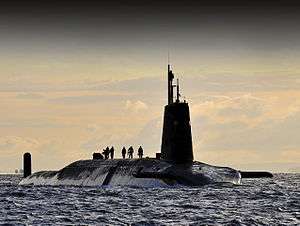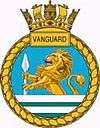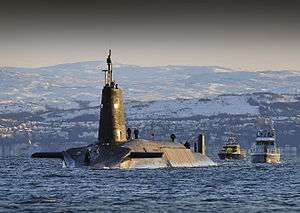HMS Vanguard (S28)
The eleventh HMS Vanguard of the Royal Navy is the lead boat of her class of Trident ballistic missile-armed submarines.[1][2] The submarine is based at Faslane, HMNB Clyde, Argyll, Scotland.
 HMS Vanguard at Faslane | |
| History | |
|---|---|
| Name: | HMS Vanguard |
| Ordered: | 30 May 1986 |
| Builder: | Vickers Shipbuilding and Engineering Ltd, Barrow-in-Furness |
| Laid down: | 3 September 1986 |
| Launched: | 4 March 1992 |
| Commissioned: | 14 August 1993 |
| Homeport: | HMNB Clyde, Argyll, Scotland |
| Status: | Undergoing refit |
| Badge: |
 |
| General characteristics | |
| Class and type: | Vanguard-class submarine |
| Displacement: | 15,900 tonnes, submerged |
| Length: | 149.9 m (491 ft 10 in) |
| Beam: | 12.8 m (42 ft 0 in) |
| Draught: | 12 m (39 ft 4 in) |
| Propulsion: |
|
| Speed: | In excess of 25 knots (46 km/h; 29 mph), submerged |
| Range: | Only limited by food and maintenance requirements. |
| Complement: | 135 |
| Sensors and processing systems: |
|
| Electronic warfare & decoys: |
|
| Armament: |
|
Vanguard was built at Barrow-in-Furness by Vickers Shipbuilding and Engineering Ltd (now BAE Systems Submarine Solutions), was launched on 4 March 1992, and commissioned on 14 August 1993.
Operational history
The submarine's first commanding officer was Captain David Russell and the senior engineer officer, during build, was Commander James Grant OBE.

In February 2002, Vanguard began a two-year refit at HMNB Devonport. The refit was completed in June 2004 and in October 2005, Vanguard completed her return to service trials (Demonstration and Shakedown Operations) with the firing of an unarmed Trident missile. During this refit, Vanguard was boarded by a pair of anti-nuclear protesters who spent half an hour on board before being challenged. They were charged with damaging a fence which they cut to access the submarine.[3]
On 4 February 2009, Vanguard collided with the French submarine Triomphant in the Atlantic.[4] She returned to Faslane in Scotland under her own power, arriving on 14 February 2009.[5]
In January 2012 radiation was detected in the PWR2 test reactor's coolant water, caused by a microscopic breach in fuel cladding. This discovery led to Vanguard being scheduled to be refuelled in its next "deep maintenance period", due to last 3.5 years from 2015, and contingency measures being applied to other Vanguard and Astute-class submarines, at a cost of £270 million. This was not revealed to the public until 2014.[6][7]
See also
References
- "Vanguard class submarine". Royal Navy.
- Jane's Fighting Ships, 2004-2005. Jane's Information Group Limited. p. 794. ISBN 0-7106-2623-1.
- "Trident pair deny criminal damage". BBC News. 13 March 2003.
- Williams, Rachel (16 February 2009). "Nuclear submarines collide in Atlantic". The Guardian. London. Retrieved 16 February 2009.
- "Nuclear subs collide in Atlantic". BBC News. 16 February 2009. Retrieved 4 May 2010.
- "Nuclear submarine to get new core after test reactor problem". BBC News. 6 March 2014. Retrieved 8 March 2014.
- Maddox, David (8 March 2014). "MoD accused of Dounreay radiation leak cover-up". The Scotsman. Retrieved 8 March 2014.